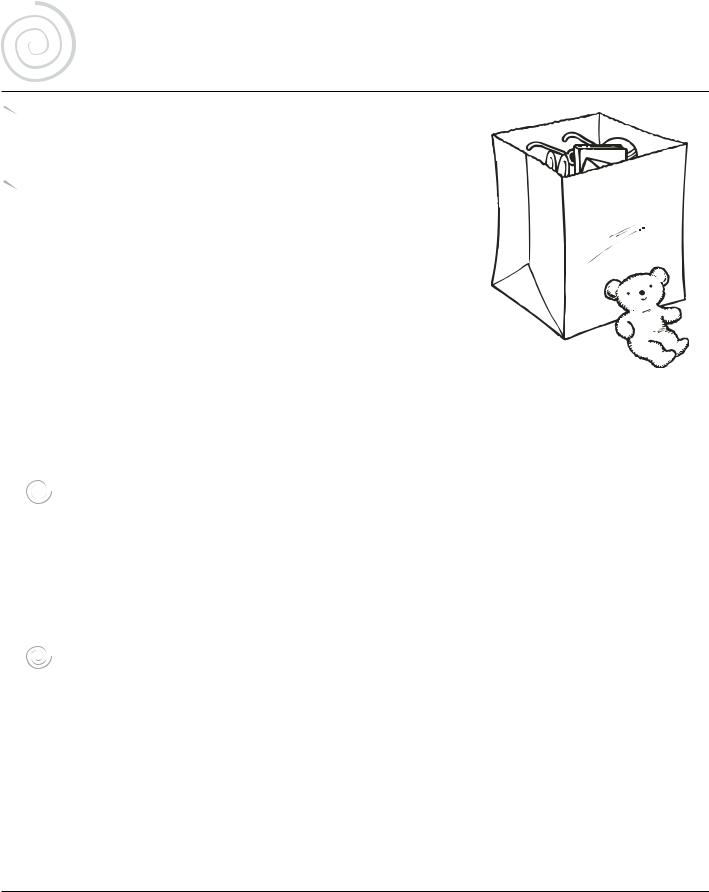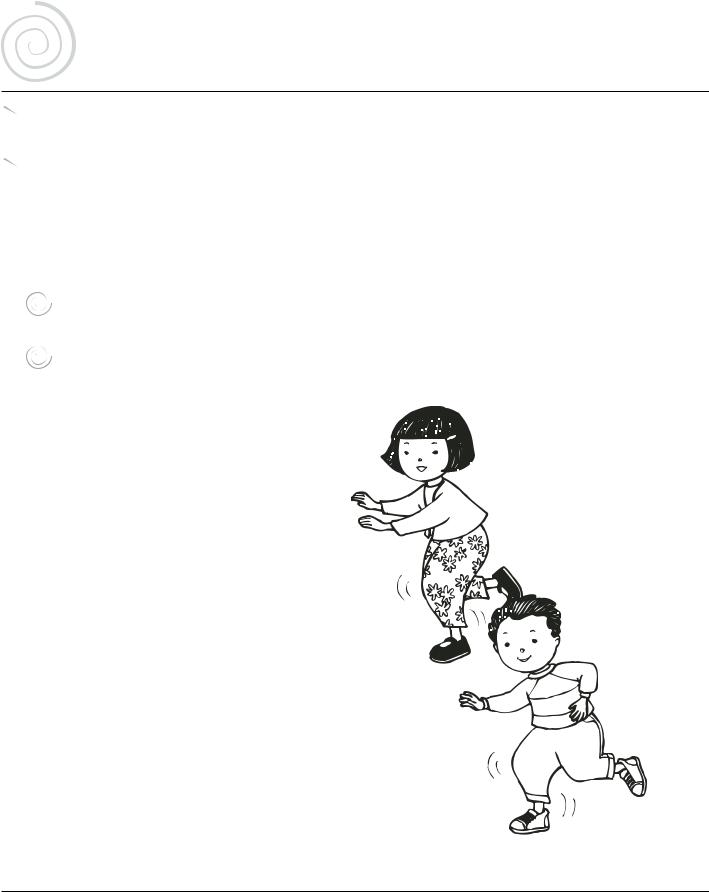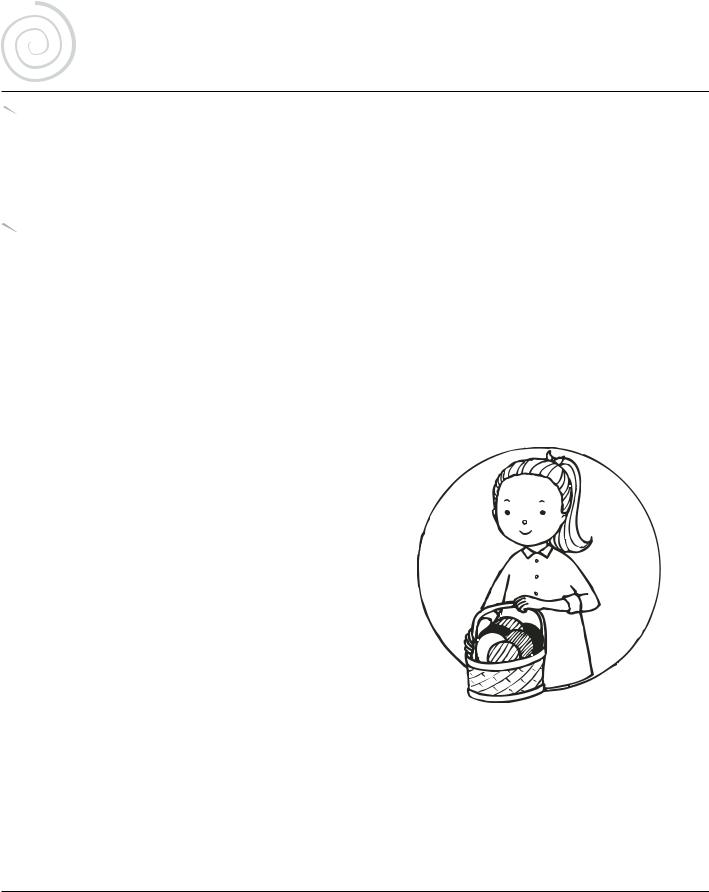
- •Table of Contents
- •Early Childhood
- •Introduction
- •Name Game
- •Up and Down
- •On the Outside
- •Rainbow Dolls
- •Responsible Me
- •The Mirror and Me
- •Positive Statements Poster
- •Talking Tube
- •The Circle of Noise
- •Happy Hands, Sad Hands
- •Feeling Faces
- •Knock, Knock
- •Friendship Ring
- •Language and Literacy
- •Wonder Why
- •What If?
- •How Many Ways?
- •Rhyming Riddles
- •Story Bag
- •Symbol Stories
- •Answers and Questions
- •Simon Says Opposites
- •Fun with Books
- •Nonverbal Communication
- •Words All Around Us
- •Alphabet Letter Magnets
- •Listen to the Sound
- •Math
- •Counting Song
- •Counting Catches
- •Number Match Game
- •Seasonal Number Rhyme
- •How Many?
- •Walk Around the Shape
- •Shapes in the Air
- •I Spy a Shape
- •Shape Bingo
- •Shape Dance
- •What Does It Weigh?
- •Lengthy Fun
- •Shape Patterns
- •Patterns in Sound
- •Science
- •People, Places, and Things
- •Same and Different
- •Bug in the Rug Game
- •Backwards Photos
- •Nature Walk Stories
- •Shadow Explorations
- •Buzz
- •The Fan Club
- •When We Were Small
- •What Is the Weather?
- •Time for Graphing
- •Sink or Float?
- •Qualities
- •Light Show
- •Music and Movement
- •Drumbeats Movement
- •Streamer Fun
- •Musical Instruments
- •Music Everywhere
- •High and Low
- •Music Detectives
- •Partners Move!
- •Moving with Scarves
- •Dance Fever
- •Visual Arts
- •Musical Collage
- •Puzzle Mural
- •Playdough Creation
- •Our Sculpture
- •Brick Building Mural
- •Sculpture Bags
- •Sticky Mural
- •Weaving Net
- •Chalk Pizza
- •Dramatic Play
- •Nursery Rhyme Fun
- •Space Adventure
- •Airplane Trip
- •Fly In and Out the Window
- •Pumpkin Patch
- •Row Your Boat
- •Mousy Moves
- •Sticky Story
- •Animals Sleeping
- •Football Practice
- •Motor Skills
- •Build a Tower
- •The Feather Dance
- •Fun with a Parachute
- •Beanbag Game
- •Hoops of Fun
- •Wading Pool Fun
- •Bubble Wrap Play
- •Dot-to-Dot Mural
- •The Friendship Squeeze
- •Musical Chairs and More
- •Moving with Carpet Squares
- •Walk the Line
- •Copycat

Language and Literacy
18 HOW MANY WAYS?
 Materials
Materials
None
 Activity
Activity
Play this language game with the children. Ask them one of the following questions. Encourage them to think of as many responses as they can. Support the children’s creative thinking by accepting all of their answers as “correct,” even the absurd ones. Continue with as many questions as you and the children would like.
How many ways can you get across the room?
How many ways can you say “hello”?
How many ways can you go down the stairs?
How many ways can you eat peanut butter?
How many ways can you show you are happy?
How many ways can you get across a river?
How many ways can you play with a ball?
19 RHYMING RIDDLES
 Materials
Materials
None
 Activity
Activity
Encourage the children’s language and listening skills with this activity. Read one of the following rhyming riddles to the children. Have them tell you what the riddle is about. Remind them that the name of the item rhymes with the word given in the riddle.
I am thinking of something that is straight or curly and rhymes with chair. What is it? (Hair.)
I am thinking of something that is red, white, and blue and rhymes with tag. What is it? (Flag.)
I am thinking of something that has windows and doors and rhymes with mouse. What is it? (House.)
Extension: Once the children are familiar with this game, let them think of their own riddles to say and solve.
© School Specialty Publishing |
20 |
1-57029-486-0 101 Circle Time Activities |

Language and Literacy
20 STORY BAG
 Materials
Materials
Objects for storytelling
Bag
 Activity
Activity
Collect a variety of interesting, non-breakable items to use while telling a story. For example, you could collect a toy car, a plastic animal, a small stuffed animal, a spoon, a block, a game piece, a small book, a crayon, a pair of sunglasses, and a hat. Place all of the objects in a cloth or paper bag.
To play the story bag game, start a simple story with an opening line such as “One day as I was walking down the street . . .” Pause and ask the child
sitting next to you to draw one of the objects out of the bag. Incorporate object into your story. If the child draws a spoon out of the bag, you could continue your story
like this “. . . I was eating a bowl of chocolate pudding. All of a sudden . . .” Ask another child to pull a new object from the story bag. Incorporate that object into your story as you continue. Keep telling your story until all of the objects are used. As the children become familiar with this activity, let them help you tell the story. Eventually, the children will be able to make up a story all by themselves.
Variation: Older children may enjoy this story-telling variation. Have the children sit in a circle. Tell the children that they will be making a story web. Let them help you choose a topic for the story, such as a day at the park, going to the beach, or playing with friends. With a ball of yarn in one of your hands, start telling your story. When you arrive at a stopping point, hold onto the end of the yarn and roll the rest of it to one of the children. Have that child continue the story for a while, then hold onto the yarn and roll the ball to another child. (Let the children who do not wish to play say “pass” and roll the yarn ball to another child in the circle.) When the story is finished, have the children look at the story “web” they have made on the floor.
Extension: Record the story bag stories as you and the children tell them. Write down the stories and let the children illustrate them.
© School Specialty Publishing |
21 |
1-57029-486-0 101 Circle Time Activities |

Language and Literacy
21 SYMBOL STORIES
 Materials
Materials
Paper
Markers
 Activity
Activity
Symbol stories encourage children to use their imagination. On a large sheet of paper, draw a symbol story line consisting of a large rectangle, a small rectangle, a wavy line, a circle, three black dots and a triangle. Show the story line to the children. Have the children think of people or objects the symbols can represent in a story. For example, for this story line the children could tell a story like this, “The mother bear and the baby bear ran down to the lake. They caught three fish and stayed in a tent.” Or, the children could tell the story this way, “The big truck and the little car drove over the mountain and stopped at a big town. They stayed for three days and went home.”
Extension: Let the children draw their own symbol story lines. Encourage them to share their stories and story lines with you.
22 ANSWERS AND QUESTIONS
 Materials
Materials
None
 Activity
Activity
Play this thought-provoking language game with the children. Give the children an “answer” and have them think up “questions” that fit the answer. Below are examples of answers and their possible questions.
Answer: Three
Question: How old is Katie? How many apples are there? How many boys wore shorts? Answer: Yes
Question: Did we read a story today? Do you like pizza? Will we sing songs? Answer: Yesterday
Question: When did we go to the library? When did we paint our pictures?
Hint: You may need to give the children many examples of this game before they catch on to how it is played. Or you may wish to begin playing this game by having the children give you the answers while you make up the questions.
© School Specialty Publishing |
22 |
1-57029-486-0 101 Circle Time Activities |

Language and Literacy
23 SIMON SAYS OPPOSITES
 Materials
Materials
None
 Activity
Activity
Test the children’s mastery of opposites with this version of Simon Says. Tell the children that you will be giving them directions to follow. If you give a regular direction such as, “Stand on one foot,” then they should follow that direction. If, however, the direction begins with the words Simon says, then they should do the opposite of what you say. For example, if you say, “Hop on one foot,” the children hop on one foot. If you say, “Simon says stand up,” the children do the opposite and sit down.
Variation: Let the children take turns giving the commands. Be sure to have them mix in regular commands with “Simon says” commands.
Extension: Sing this song to the children. Have them listen carefully for the regular commands and the “Simon says” commands. Once they have mastered the actions, let them help you make up additional verses to sing.
Sung to: “Three Blind Mice”
Hop on one foot.
(Hop on one foot.)
Hop on the other.
(Hop on other foot.)
Simon says “stand up.”
(Do the opposite—sit down.)
Simon says “sit down.”
(Do the opposite—stand up.)
Now it’s time to spin around,
(Spin around.)
Simon says “please touch the ground,”
(Do the opposite—reach up to the sky.)
Simon says “run around.”
(Do the opposite—walk in place.)
Now please stop.
(Stand still.)
Gayle Bittinger
© School Specialty Publishing |
23 |
1-57029-486-0 101 Circle Time Activities |

Language and Literacy
24 COLORFUL EGGS
 Materials
Materials
Various colors of construction paper
Scissors
Basket
 Activity
Activity
Cut six-inch egg shapes out of pink, red, green, white, blue, and yellow construction paper. Make sure you have enough eggs so that each child can have one. Have the children sit in a circle. Choose one child to be the bunny and give the child a basket. Pass out the paper egg shapes to the remaining children, handing out at least one egg of every color. Read the first three verses of the following rhyme. In the third verse, substitute the number of children holding pink eggs for the word one. Have the bunny hop around the circle, picking up all of the pink eggs, counting as he or she goes. Repeat for each of the next five verses. During the last verse, have the bunny redistribute the eggs. Choose another child to be the bunny and begin again.
There once was a bunny who came to town,
Carrying a basket big and brown.
The bunny went here, the bunny went there,
Looking for eggs everywhere!
“I’m getting near, that’s what I think.” Then he found one egg colored pink.
He looked some more, and scratched his head.
Then he found one egg colored red.
These eggs were the prettiest he’d ever seen.
Then he found one egg colored green.
Hunting for eggs was such a delight.
Soon he found one egg colored white.
The bunny was happy, you would be, too.
Then he found one more egg colored blue.
“My, oh, my,” he said, “I’m such a lucky fellow,” When at last he found one egg colored yellow.
“My basket is so full, oh, what can I do? I know, I’ll share my eggs with you.”
Jean Warren
Susan Paprocki
© School Specialty Publishing |
24 |
1-57029-486-0 101 Circle Time Activities |

Language and Literacy
25 SYMBOLIC PROP STORIES
 Materials
Materials
Various
 Activity
Activity
Storytelling props, such as hats, puppets, and flannelboard figures can bring literature to life for preschoolers. Props capture children’s attention and help young minds visualize story characters and action. But choosing story props ahead of time can also deny children an opportunity to use their imagination. Once in a while, it’s fun to let the children decide what props should be used to tell a story. The benefits are many: Children get to use their imaginations; there are no right or wrong choices; everyone successfully contributes to the story; children learn that they can act out stories even if they do not have the exact story characters to play with; and searching for symbolic characters helps children strengthen their thinking skills.
To begin with, choose a story the children are familiar with, such as “The Three Bears.” Guide the children in following these four simple steps.
Step |
Example |
|
|
|
|
1. |
Determine what props you will need. |
For “The Three Bears” you will need three bears, |
|
|
Goldilocks, three bowls, three chairs, and three |
|
|
beds. |
|
|
|
2. |
Now you’re ready to begin collecting props. |
For this story you will need bowls, chairs, and |
|
Start with the items that establish the |
beds in three different sizes. For the three |
|
setting of the story. |
bowls, the children may decide on small, |
|
|
medium, and large blocks. For the three chairs, |
|
|
they may choose a cup, a pan, and a book. For |
|
|
the three beds, they may select a blanket, a |
|
|
pillow, and a shoe box. |
|
|
|
3. |
Next, ask the children to find items to |
For this story you will need three different |
|
represent the characters in the story. |
sizes of bears and a child. The children |
|
|
may choose a toy car, a beanbag, and a hat to |
|
|
represent the bears, and a marker to stand in for |
|
|
Goldilocks. |
|
|
|
4. |
Now that you have your story characters, |
As you tell the story, invite the children |
|
let the story begin. Strive to include all of |
to come up and move the props around. |
|
the children in the storytelling. |
|
|
|
|
© School Specialty Publishing |
25 |
1-57029-486-0 101 Circle Time Activities |
